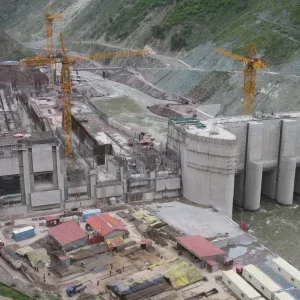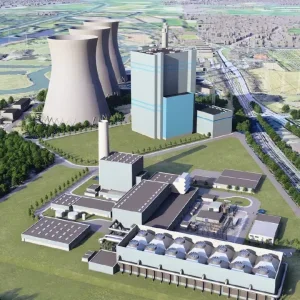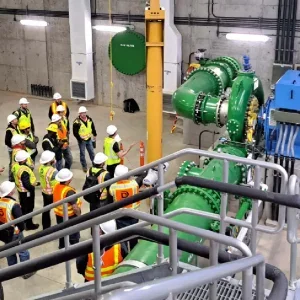In comparison with hydrogen technology, air-cooled generators are simpler, leading to benefits such as higher reliability, less maintenance, lower plant costs and faster delivery. But because air is an inherently less efficient heat transfer medium than hydrogen, there have been restrictions on the size of machines to which air cooling can be economically applied (Figure 1).
In recent years, however, thanks to intensive development efforts, the size limits on air-cooled generators have been steadily increasing – to the point where the 500 MVA barrier was contemplated (see MPS, May 1999, pp 31-35) and has now been breached. The driver for the increased unit rating of the air-cooled generator has been the evolution of larger gas turbine and combined cycle plants, which tend to use air-cooled machines because of their simplicity in terms of design, construction and operation, and consequent good economics.
The higher ratings for air-cooled generators have been achieved by increasing active dimensions and by increasing specific utilisation. The main contributor to increasing specific utilisation is a refinement in the cooling system using reverse flow, and Class F thermal utilisation (155°C) combined with an insulation system qualified for Class H (180°C).
The new 500 MVA generator is called TOPAIR 25. Some basic data is given in Table 1, and compared with the corresponding hydrogen-cooled type (TOPGAS) and the earlier, air-cooled TOPAIR 23, which is rated at 300 MVA and was introduced in 1995.
With TOPAIR 25, the generator efficiency has been kept at the level of the 300 MVA air-cooled machine, and in terms of overall power plant efficiency the choice between air-cooled generator of this type and hydrogen-cooled technology is negligible. The active dimensions of the new generator are larger than a comparable hydrogen-cooled unit, but due to the simpler and less heavy housing, transportation weight is only moderately larger and railway transport possible. The overall generator length is about the same due to the absence of shaft sealing.
The new 500 MVA generator (Figures 2 and 3) has all the proven features (Figures 4, and 5) of the 300 MVA family, such as the fully welded housing, the suspension of the built-in stator through fully welded leaf spring connections, pedestal bearings mounted on the housing extensions, terminals arranged on top and TEWAC (see below).
To keep the housing within the rail transport profile the cooler elements are arranged below the housing in the concrete foundation and the fan discharge is in the form of a radial diffuser and supported by external bypass tubes leading to the coolers. This also contributes to a considerable saving in machine length. The foundation is provided with sufficient space for transverse cooler withdrawal. The space above the coolers is filled with a coolant mixing structure to provide equalised cold air temperature in case one cooler element should fail.
The built-in stator uses the same elements as the 300 MVA series: core clamped with aluminium pressplates, single-bar VPI-insulated Roebel bars, and the retightenable end-winding supporting system.
An additional element in the 500 MVA machine is an air-guide vane (Figure 6) at each rotor air-intake, mounted in the form of two half-shells between the inner side of the retaining ring and the shaft.
Reverse cooling concept
Cooling is the key to the great leap forward in generator technology that TOPAIR 25 represents. In particular, the reverse cooling concept is employed, in which the axial cooling of the rotor and the axial segmentation of the radially cooled stator, both proven ventilation principles, are maintained. Figure 7 shows schematically the coolant flow in the Topair 25 cooling circuit.
The reverse cooling concept has the fans arranged upstream of the coolers. Thus the active part can be supplied with cold air directly from the coolers without pre-heating of the coolant resulting from the work input of the fans. In the case of the TOPAIR 25 generator, a coolant pre-heating of more than 10K can thus be eliminated. As in the standard design there are two symmetric, closed-loop cooling circuits, each responsible for one half of the machine. The losses of the entire system are removed by six water/air coolers embedded within the foundation. This is a closed air circuit system known as Totally Enclosed Water-Air Cooling (TEWAC), and is widely used in large air-cooled generators.
There are three major parallel flow paths within the generator:
• The first, the main coolant path, enters the stator end-winding section, where the coolant flow is controlled and equally distributed in the tangential direction. The end-windings are cooled by the flow moving radially inwards to the air-gap entrance. The flow enters the coolant ducts of the first cooling chamber.
• The second flow path is divided from the first path upstream of the stator end-winding section to achieve pure cold-gas rotor-intake conditions. The coolant passes a rotor air-guide vane and is supplied to the field winding. The two-zone axial cooling in the active part is identical to the proven TOPAIR 23 design. The rotor air is mixed with the coolant from the air-gap and discharged radially through special stator cooling ducts.
• The third flow path supplies the cold air for the stator cooling in the remaining middle part of the generator. Here the flow within the coolant ducts is at first directed radially inwards. A part of the coolant is finally discharged into the air-gap. The other portion of the stator coolant is U-turned within the stator slot and leaves through the next duct without any exchange with the air-gap flow. Thus the cooling capacity of the stator coolant has been kept for the return path, and cooling of the core close to rotor coolant exhaust ducts is ensured. Outside the core, the three flows join. This method allows the controlled and concentrated exhaust of rotor hot air through the special stator ducts.
The refined segmentation results in a homogeneous axial temperature distribution in the indirectly cooled stator winding, leading to equalised thermal utilisation of the insulation. This is crucial in getting to 500 MVA by air cooling.
Insulation issues
Another important area of improvement embodied in TOPAIR 25 is in the insulation. The 500 MVA machine is intended to operate under Class F thermal conditions. But maintaining the established practice of having an additional capability of one temperature class for the insulation, a class H insulation system has been introduced in the TOPAIR 25. The development work addressed three main fields of activity: stator bar insulation, rotor insulation and insulating materials for other purposes.
For stator insulation, the starting point was the well proven Micadur® insulation system, which has been qualified for at least class F and has had excellent operating experience over the past 40 years. The existing system was then modified to fulfil class H requirements. This improved system was subsequently named Micadur class H.
The main development activities were concentrated on the impregnation resin, a modified epoxy resin, and the mica tape used for the ground-wall insulation. The strand insulation already fulfilled class H requirements. Improvement of the recipe for the impregnation resin and the optimisation of the mica tape led to results exceeding the required properties. These results were then verified on samples, with numerous short and long-term investigations.
Qualification testing was then done according to IEC 60505 as a Class H system. Tests suggested at least a 25K gain in temperature for the same endurance specification for the new Micadur class H compared with standard Micadur.
For the rotor, the slot channels are made of Nomex, a material with intrinsic class H capability. The interturn insulation between the copper conductors in the active part and the spacer elements in the end-windings are made of glass reinforced plastics, which are also available in Class H quality. Development work therefore concentrated on evaluating the best materials by comparing samples and thoroughly specifying the required properties where critical.
Insulation materials for other purposes include spacer elements for different purposes, varnish, adhesives, putty, etc, which are not in contact with the live conductors. The thermal specifications for these materials were evaluated individually according to the actual temperatures the components are subjected to, ie the materials are qualified to the level appropriate to each case.
Fluid mechanics and heat transfer
The overall behaviour of the air flow within the generator was studied by means of comprehensive 1D-flow network calculations with a total of 235 elements representing one symmetrical half of the generator. The accuracy of such computations depends significantly on the modelling of the air-gap flow, which dominates the axial coolant distribution of the stator. Building on previous modelling, the complex swirling flow within the air-gap has been examined analytically and experimentally. This has led to a model which is able to predict the key flow parameters along the air-gap. Based upon these fluid mechanical considerations, heat transfer properties and rotor surface friction losses were also derived.
Fluid mechanical investigations concerning the generator rotor have focused on the rotor inlet section.
As already noted, the TOPAIR 25 has air-guide vanes (AGVs) (see Figure 6). These are used to achieve equal flow and thus equal thermal conditions. It helps also in providing a reduction in rotor inlet pressure drop. The AGV is aerodynamically high-loaded and was therefore investigated in detail. Tests included experimental flat water optimisations, CFD calculations and a study of the effect of the AGV on the flow distribution among the rotor slots during the balancing and spinning of the rotor. For the latter, fast time resolved hot wire anemometry (Figure 8) was used to record the tangential velocity distribution of the flow leaving the rotor on its circumference at different axial locations.
On the basis of these tests, the AGV has proved itself to be an essential part of the TOPAIR 25, permitting rotor operation at a high level of thermal utilisation with an equalised thermal stress among the slots.
A further example of the extensive fluid mechanics investigations undertaken was in the design and testing of the TOPAIR 25’s axial fans, the most important component of the cooling circuit. The fan consists of an axial impeller with a downstream radial diffuser (Figure 9).
Finally, a full scale full speed main blower test was performed (see Figure 10).
Operating experience
In May 1998 the first TOPAIR 25 unit built underwent a detailed type test programme under the following conditions: 480 MVA, power factor 0.85, 50 Hz, Class F thermal utilisation. This test, witnessed by Lloyds, was carried out at the Dolmel facility, Wroclaw, Poland. The type tests were performed according to IEC34.
The measured temperature rises in the rotor and stator windings were distinctly better than expected. This is due to the contribution of the rotor air-guide vane and the measures implemented on the stator cooling system turning out to be more effective than expected. Based on the tests, the machine was uprated to 500 MVA, while still keeping the safe margins to Class F limits.
The efficiency reached 98.78 per cent, which is similar to the 300 MVA type. Figure 11 shows the relative contribution of the various sources of losses for the TOPAIR 25 and other machines, smaller air-cooled units and a hydrogen-cooled generator of similar rating. It can be seen, that thanks to the measures described above, the contribution from ventilation loss has been maintained at roughly the same level relative to the 300 MVA machine. So the development effort has paid off.
No problems occurred with regard to the mechanical behaviour of the generator. Shaft and bearing vibrations remained at a low level. Critical speeds and torsional natural frequencies were measured as being safely located between exciting frequencies. A modal analysis of the stator winding overhangs suggested that relevant natural frequencies were more than 10 per cent below exciting double running frequency. The measured sound radiation level was 89 dB(A).
In parallel with the type tests a couple of special measurement programmes were carried out to provide further detailed insights into the performance of the generator. Measurements from some 280 pressure taps/probes and 90 flow temperature pick-ups distributed around the generator served to confirm the coolant distribution, particularly within the stator cooling ducts and the air gap. Furthermore, key flow resistances within the coolant circuit were estimated experimentally.
One innovation was that fibre-optic temperature sensors with a wire diameter of less than 1 mm were installed inside the stator bar groundwall insulation in direct contact with the copper strands. Although no problems arose from the HV-potential and not even from the VPI process, the fibre-optics suffered numerous failures caused by mechanical damage during handling and mounting of the bars. However, once installed the fibre-optic probes reliably delivered valuable information about local copper temperatures. Where redundant installation is possible, as in the case of equivalent places in corresponding slots, the fibre-optics has proved to be a powerful development tool. In addition to classic RTD measurements, the fibre-optics provided verification of existing temperature-rise margins, not only for the copper in the active regions, but also for the end-windings and the lugs.
Outlook
Air-cooled technology provides significant benefits to the customer, in terms of both first and running costs. This applies to gas turbine/combined cycle and steam-turbine applications.
In the near future a 60 Hz version of the TOPAIR 25 will be developed, upon customer demand. This is expected to have a power rating around 450 MVA.
The use of the TEWAC design, as already employed, opens up the possibility of further increasing the unit rating by increasing the static pressure. The housing of the TOPAIR 25 generator is designed for up to 0.3 bar overpressure.
Further potential for uprating and upgrading in the long term lies in the reserve maintained in the temperature class, which means that the machine can be used, at least for peaking operation, in the Class H region, for which the existing main insulation material is qualified.
For future designs, further increases in unit rating could be achieved with the lifting of certain boundary restrictions, such as the railway transportation profile.
Given all these possibilities the TOPAIR 25 generator should be able to meet the needs of future upgraded gas turbines. Also, once installed in a plant, it will also be able to accommodate any future uprating packages carried out on the gas turbines.
Tables
Comparison of TOPAIR 25, TOPGAS and TOPAIR 23 basic data






